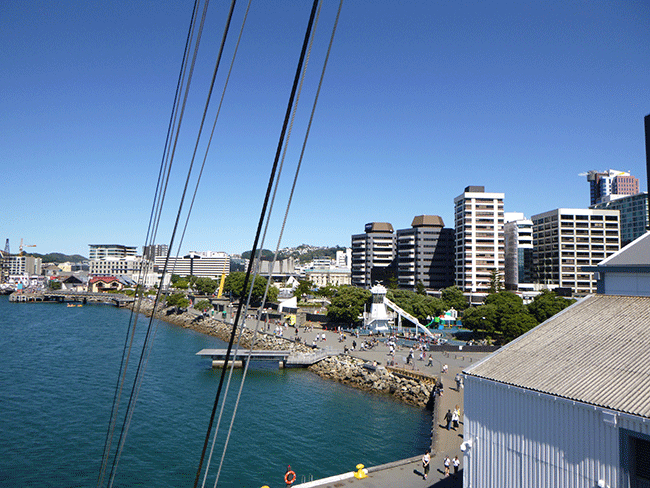Programs Blog
Human Uses of Ocean Space Consensus: Wellington

Marija Miklavčič, University of Rochester
Ship’s Log
Despite the choppiness of the sea following the last of our gales, we arrived at Wellington Harbor enough ahead of schedule that we hove to for the night in Cook Strait. Even with doing that, we docked off of Queens Wharf around 1130, after only a few hours of navigating our way through the harbor. I had planned to be up to enjoy the approach, but as I had been on dawn watch, I woke up as we were already preparing to dock in Lambton Harbor. After having been at sea for twelve days and having seen absolutely nothing other than two ships, it was quite the surprise to go on deck and suddenly see a city! After the approach to Aotea Great Barrier Island and having expected us to still be some ways away from our final docking, I had expected to first be surrounded by lush green forests and dense vegetation.
Instead, Wellington looks much like any modern city, although in a comparatively small allotment of space. To the right of Queens Wharf (where we docked) is a long pedestrian walkway bordered on one side by the harbor and small storefronts on the other. Eventually – after about a five-minute walk – the walkway meets Te Papa – a museum of New Zealand’s natural, Māori, and European histories and cultures. Beyond that, the city continues, but it quickly morphs into a much more residential scene. Tightly packed homes cover the hillside while a marina claims the waterfront. A massive monastery catches the eye, its orange brick walls contrasting from the uniformity of the white buildings surrounding it. Just past the marina is a beach area, followed by more waterfront property giving way to a rocky and densely vegetated point. To the left of the Robert C. Seamans, the waterfront is much more industrial, although the city continues – in the form of the business district now, rather than the downtown – behind the shipping areas – before merging with extensive natural lands.
In comparison to our three previous ports, Wellington stands apart, as each has. Wellington, unarguably, is far smaller than Auckland, although, in my opinion, far more interesting and enjoyable. Nature reserves like Zealandia are much easier to access and the diminutive layout makes it much easier to navigate. It’s difficult to get lost when you always have the harbor on one side and forested hills on the other. On the other hand, Wellington is far larger than Kororareka Russell and incomparable to Aotea Great Barrier Island. Kororareka Russell was primarily comprised of a single strip of storefronts, a natural area, and loosely congregated residences. Aotea Great Barrier Island was essentially all a nature reserve with a handful of houses and buildings scattered across it.
The use of the waterfront in Wellington is very diverse with a bit of everything – industry, commerce, recreation, and residence. It is a busy area with business people commuting along the waterfront walkway via scooter, tourists going for strolls with cones of ice cream in hand, and locals taking walks with friends and family stopping to sit on the benches to catch up and enjoy the view. We too enjoyed our time there, wandering through downtown and the botanical gardens during the day to come back home to the Bobby C. each night.
Our journey has come to an abrupt end, but there are few places that would have been more enjoyable in which to come to terms with the seeming chaos that has cloaked the Earth since our departure from Aotea Great Barrier Island. It has been an amazing run, and I wouldn’t have changed a single moment of the trip. I couldn’t have asked for better shipmates and crew for this adventure aboard the beautiful SSV Robert C. Seamans. Thank you to everyone, on sea and shore, who helped to make this unforgettable experience one of magic and laughter. Until we meet again…
– Marija Miklavčič
Recent Posts from the Ships
- SEA Writer 2022, Magazines From the Summer SEA Quest Students
- PIPA Alumni Reconnect with Children of Kanton
- Woods Hole Welcomes Incoming Class of PEP Students
- Muhlenberg Student Finds Perfect Study Abroad Experience with SEA Semester
- SEA Student Describes Pacific Exploration for University of Denver News
Programs
- Gap Year
- Ocean Exploration
- High School
- Science at SEA
- SEA Expedition
- SEAScape
- Pre-College
- Proctor Ocean Classroom
- Protecting the Phoenix Islands
- Sargassum Ecosystem
- SPICE
- Stanford@SEA
- Undergraduate
- Climate and Society
- Climate Change and Coastal Resilience
- Coral Reef Conservation
- Marine Biodiversity and Conservation
- MBL
- Ocean Exploration: Plastics
- Ocean Policy: Marine Protected Areas
- Oceans and Climate
- Pacific Reef Expedition
- S-299 Summer Session
- The Global Ocean: Hawai'i
- The Global Ocean: New Zealand